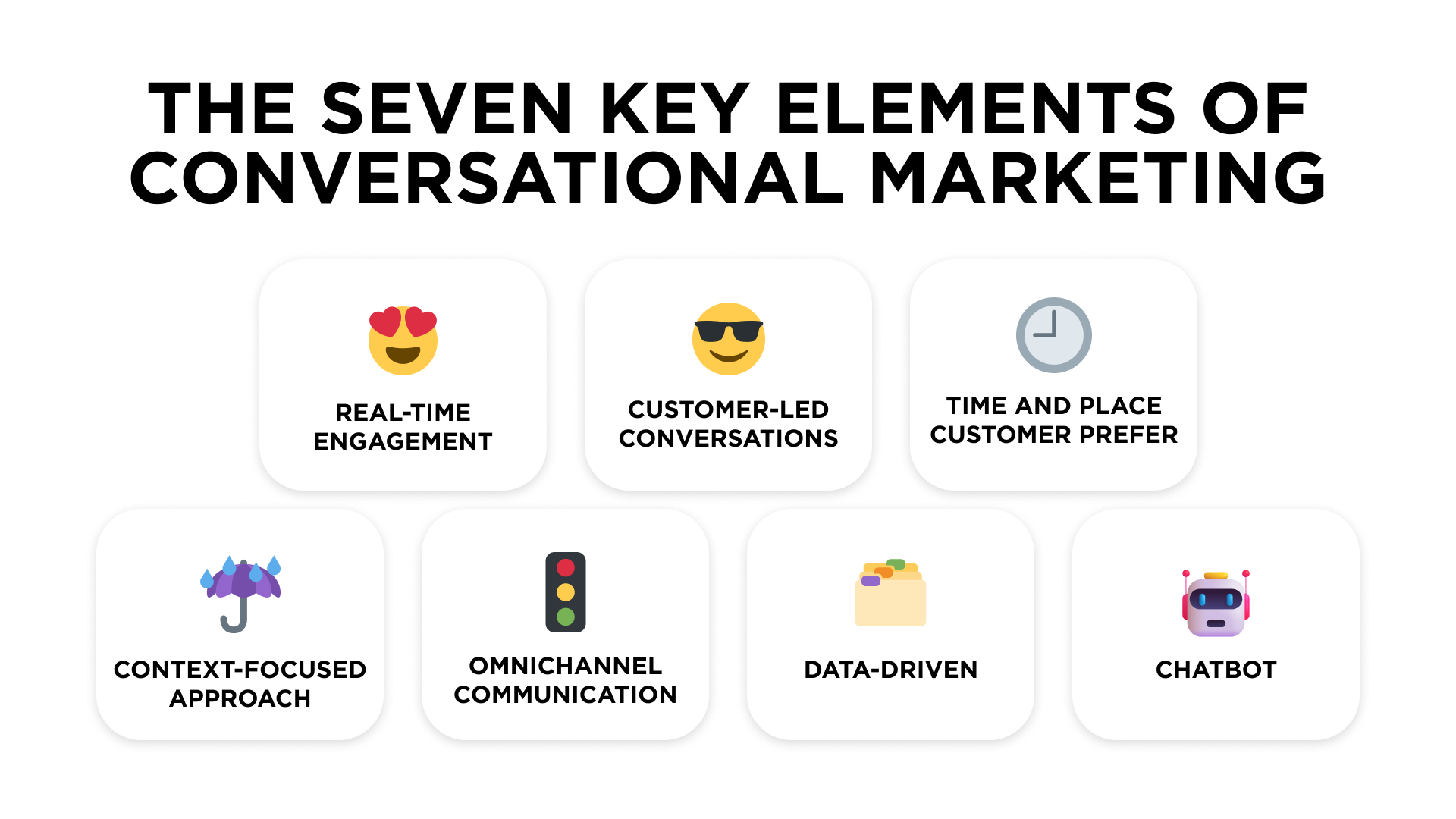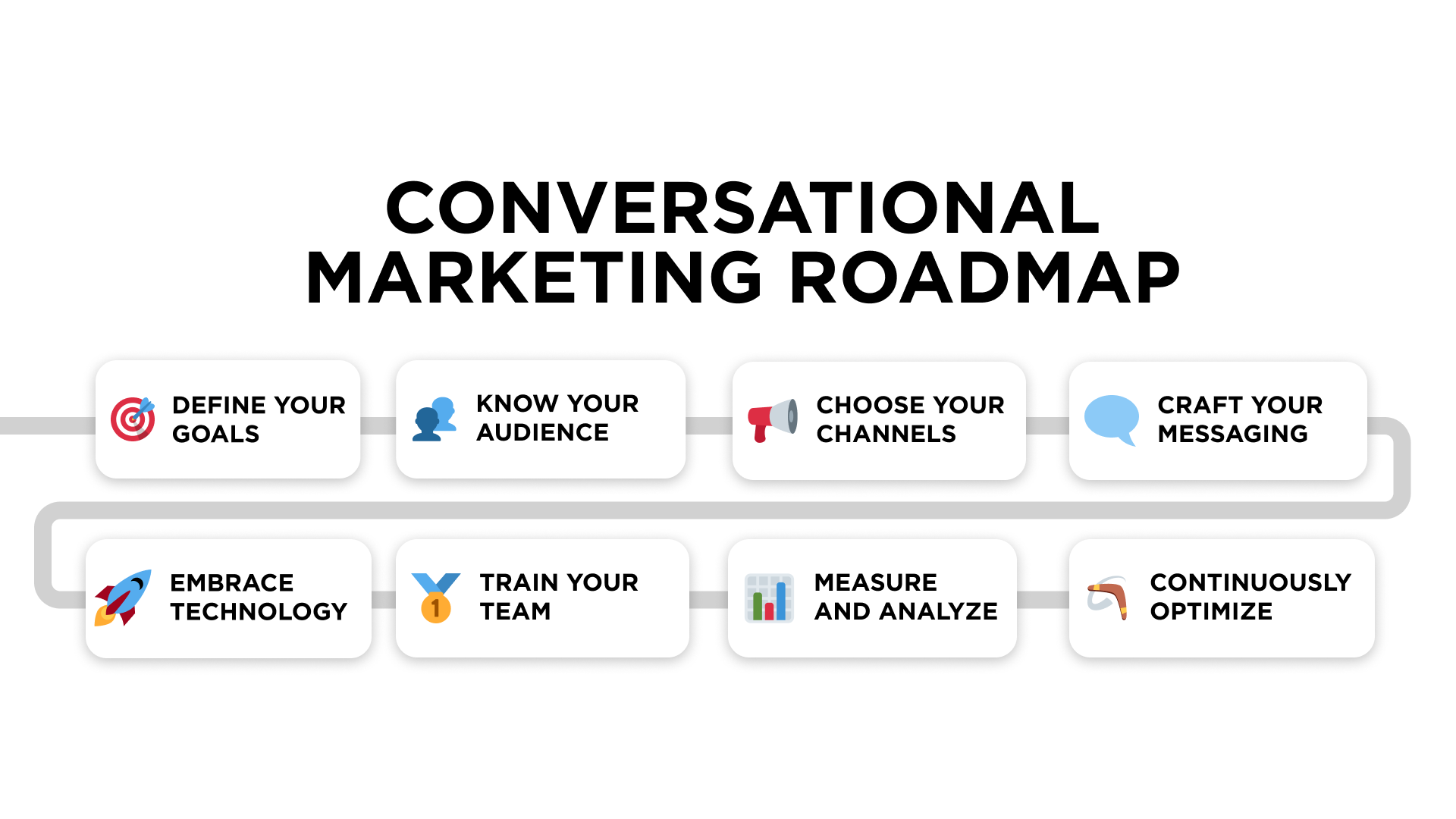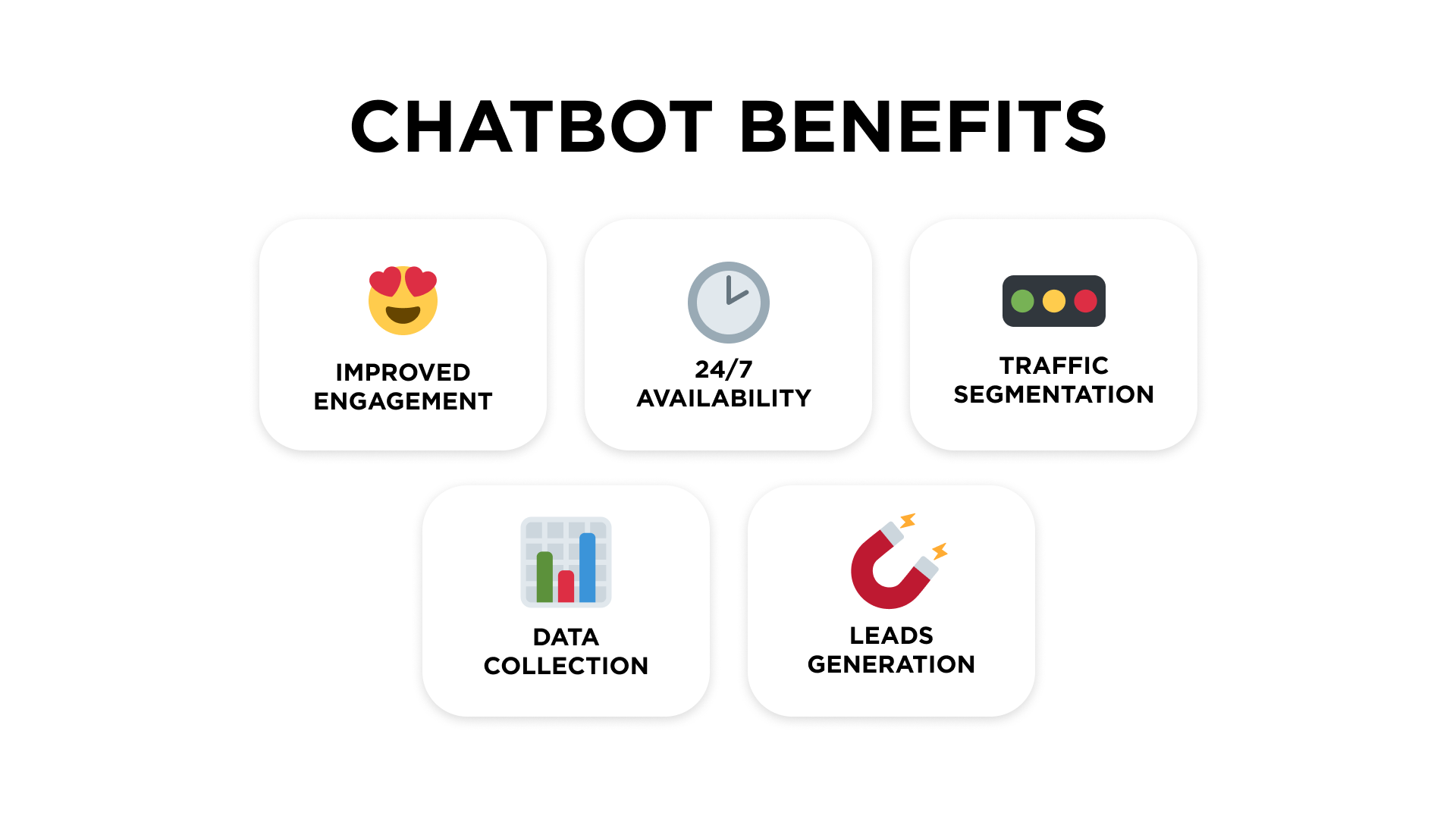What is Conversational Marketing (Its Strategy, Benefits, and Examples)?
Let’s find out what Conversational Marketing is and how to take advantage of it.

Conversational marketing comes in where it's vital to engage an audience in real-time conversations to build relationships and ultimately drive conversions. Moreover, by adopting a strategic approach that focuses on personalized and interactive conversations, brands can create meaningful connections, understand customer needs, and drive better results.
In this article, I will review conversational marketing and delve into its key strategies and tactics. From leveraging chatbots and AI-powered messaging platforms to implementing personalized content and targeted campaigns, I will explore how brands can effectively engage with their audience and achieve their marketing goals.
With this guide, you will uncover the secrets to successful conversational marketing and discover how to elevate your brand's engagement and conversion rates in today's competitive digital landscape. So, if you want to learn more about conversational marketing? You’ve come to the right place. Let's jump right in.
Table of contents
What is conversational marketing?
Conversational marketing is a marketing strategy that emphasizes real-time, personalized interactions with customers across multiple channels. It involves using messengers, chatbots, AI-powered messaging platforms like Umnico, and other tools to engage with customers conversationally.Unlike traditional marketing techniques that rely on one-way communication, conversational marketing aims to create a dialogue between brands and their audience. Such marketing can take many forms, including live chat, social media messaging, and personalized email campaigns.
The goal is to make customers feel heard, understood, and valued, ultimately leading to increased customer satisfaction and loyalty.
What are the key elements of conversational marketing?
Conversational marketing flips the script on traditional marketing by prioritizing two-way communication in real-time. Here are the key components that turn your regular marketing strategy into a conversational one.

- Real-time engagement: Nowadays, consumers expect instant gratification and quick responses to their inquiries. When engaging with customers promptly, brands can provide immediate support, answer questions, and address concerns, leading to a positive customer experience.
- Customer-led conversations: The focus is on giving customers control over the pace and direction of the conversation. They should feel empowered to ask questions and get the information they need when they need it.
- Customer terms: Conversational marketing uses channels where your target audience already is, like live chat platforms, messaging apps, and social media. This makes it easier for them to engage with your brand.
- Context-focused approach: Effective conversations consider the history of interactions with a customer; it allows you to personalize your responses and provide relevant information.
- Omnichannel experience: The experience should be consistent across all channels, so customers don't feel like they're starting from scratch each time they interact with your business.
- Data-driven: Conversational marketing generates a wealth of data about customer preferences and buying habits. Keep analyzing this data, and you can continuously improve your marketing efforts.
- Reasonable automation: Chatbots can handle many common questions and requests, freeing up your team to focus on more complex interactions. But remember, even with automation, a human touch is still important.
You have already discovered the basics of conversational marketing, so I am ready to guide you on more advanced sides of real-time customer engagement with dialogues.
What makes conversational marketing important?
Instead of pushing for a quick sale, conversational marketing builds relationships. Forget the one-way broadcast of traditional marketing. Conversational marketing lets you connect with customers on their terms, through live chat, chatbots, or social media. This doesn't just answer questions and guide them to what they need, it also gathers valuable insights empowering your sales team with a deeper understanding of prospects before that crucial sales conversation. The result? More meaningful interactions and a smoother path to happy customers.

Conversational marketing isn't about ditching everything you already do. It's about giving your audience options. You can still use lead capture forms and traditional marketing methods, but conversational marketing adds another tool to your belt. It lets customers choose how they want to interact with you, whether it's live chat, instant messengers, social media, or a good old-fashioned email. This multi-channel approach not only boosts engagement but also helps move visitors through the sales funnel faster and more efficiently , leading to higher conversion rates. That's why conversational marketing is becoming increasingly popular!
Conversational marketing statistics
The effectiveness of conversational marketing is supported by numerous statistics.

According to a study by Drift, businesses that use conversational marketing as part of their strategy have seen a 10% increase in customer satisfaction, a 10% increase in qualified leads, and a 7% increase in revenue.
Another study by HubSpot found that 82% of consumers expect an immediate response from a brand when they have a question or need assistance. Additionally, 48% of consumers would prefer to communicate with a company through live chat, compared to just 5% who prefer email.
These statistics highlight the growing importance of conversational marketing in today's consumer-driven world. Brands that prioritize real-time engagement and personalized conversations are more likely to build strong connections with their audience and achieve better results.
Benefits of conversational marketing
Conversational marketing offers a plethora of benefits for businesses looking to enhance their marketing efforts. Here are some key advantages:
- Improved customer experience: By engaging in real-time conversations, brands can provide immediate support and personalized recommendations, leading to a more positive customer experience.
- Increased customer engagement: Conversational marketing encourages customers to actively participate in the conversation, leading to higher engagement rates and a deeper connection with the brand.
- Better understanding of customer needs: Through conversations, brands can gain valuable insights into customer preferences, pain points, and motivations, allowing them to tailor their marketing strategies accordingly.
- Higher conversion rates: By providing personalized recommendations and addressing customer concerns in real-time, conversational marketing can lead to higher conversion rates and increased sales.
- Improved customer retention: By building strong relationships and providing exceptional customer service, brands can foster customer loyalty and increase customer retention rates.
Some drawbacks of conversational marketing
Conversational marketing, while powerful, isn't without its challenges. When implementing a real-time engagement-based approach you should consider several limitations and cons of that marketing strategy.
- Misinterpretations and Frustration: Even the most advanced chatbots can misunderstand complex questions or user intent. This can lead to frustration for customers who don't get the answers they need, potentially damaging trust in your brand.
- Limited to Simple Interactions: Conversational marketing excels at handling basic questions and requests. However, it can struggle with intricate issues or situations that require a human touch and nuanced understanding.
- Resource Investment: Developing and maintaining effective conversational marketing tools requires ongoing investment in technology, training, and personnel. For smaller businesses, this can be a significant cost factor.
- Data Privacy Concerns: Conversational marketing generates a wealth of customer data. Ensuring this data is collected, stored, and used responsibly is crucial to avoid privacy concerns and potential regulatory issues.
- Always-On Expectation: If you offer 24/7 chat support with chatbots, customers might expect the same level of responsiveness from all channels. Managing expectations and ensuring clear communication about availability is essential.
By being aware of these drawbacks and implementing them strategically, marketers can leverage the power of conversational marketing while mitigating its limitations.
How is conversational marketing changing the way customers buy?
The buying process (especially in B2B) has become senseless, impersonal, and way more distressing for the buyer than it ought to be. Conversational marketing is shaking things up in the world of customer buying journeys by making the process more interactive and customer-centric. Here's how:
- Empowerment over Interruption: Traditionally, marketing aimed to push messages and influence customers quickly. Conversational marketing flips this by putting the customer in the driver's seat. They can ask questions, get personalized recommendations, and engage at their own pace.
- Frictionless Information: Imagine needing info and having it instantly available through a chat window or chatbot. Conversational marketing removes the frustration of searching for answers on a website. Customers get what they need when they need it.
- Right Message, Right Time: Conversational marketing tools can analyze past interactions and tailor recommendations or support to a customer's specific needs. This relevancy builds trust and makes the buying process more efficient.
- Reduced Burden, Increased Value: Chatbots can handle routine questions and requests, freeing up sales reps for more complex interactions. This personalized approach allows for deeper customer connections and more meaningful sales conversations.
- Seamless Omnichannel Experience: Whether it's live chat, messaging apps, or social media, conversational marketing meets customers where they are. This creates a smooth, consistent experience across all channels.
The rise of messaging isn't a mystery anymore. It's fast, convenient, and feels natural, just like a conversation. No wonder popular communication channels in 2024 reflected this trend, with online live chat, phone calls, and even email remaining top choices.
How do you start utilizing conversational marketing?
Conversational marketing isn't an overhaul, it's an upgrade for your business! Think of it as adding a new lane to your lead generation highway, working alongside your existing marketing efforts.

To take the first step to the way of adopting conversational marketing you need to start generating more chats instead of leads. Whether your prospects downloading a resource, reaching out for sales, or booking a demo, keep the conversation going right then. Engage visitors with a live chat instead of keeping them waiting for a follow-up email (unless they prefer that, of course). It's a smoother journey through your funnel, keeping them interested and moving them along the path to becoming a customer.
Adopt chatbots and conversational AI to qualify leads and discover true customer needs. By answering questions such conversational AI as GPT-4 can use its smarts to understand exactly who your website visitors are and what they're looking for. This real-time lead qualification helps your sales team segment and identify high-potential leads right away.
After scoring your leads with the right credit, beginallocating them among sales reps who should move your leads through the sales funnel with a personalized Call To Action. Having all the data on particular prospects in one place, they can nurture a lead to the next stage by further qualification and delivering relevant content over time.
Conversational marketing roadmap

Here's a roadmap to get you ready for conversational marketing:
- Define your goals: First things first, identify what you want to achieve with conversational marketing. Do you want to improve lead generation, enhance customer support, or boost brand awareness? Having clear goals will guide your strategy and help you measure success.
- Know your audience: Understanding your target audience is crucial. What communication channels do they prefer? What are their pain points and buying behaviors? Tailoring your approach to their preferences will lead to more engaging conversations.
- Choose your channels: There's a range of channels for conversational marketing. Live chat, messaging apps (like WhatsApp or Facebook Messenger), and social media are all popular options. Select the channels where your audience spends their time.
- Craft your messaging: Develop a conversational tone for your interactions. It should be friendly, informative, and aligned with your brand voice. Focus on providing value and addressing customer needs.
- Embrace technology: Consider utilizing chatbots to handle basic inquiries and automate tasks. This frees up your team for more complex interactions and provides 24/7 customer support.
- Train your team: Equip your team with the skills and knowledge to excel in conversational marketing. This includes active listening, effective communication techniques, and product expertise.
- Measure and analyze: Track key metrics like customer satisfaction, lead generation, and conversion rates. Analyze this data to identify what's working and what needs improvement.
- Continuously optimize: Conversational marketing is an ongoing process. By regularly reviewing data and adapting your strategy, you can ensure your conversations are delivering the best possible customer experience.
Now, when you are familiar with all important aspects of conversational marketing and its implementation, you can move further by discovering conversational marketing strategies and best practices.
What is a conversational marketing strategy?
A conversational marketing strategy is a well-defined plan of action aimed at creating two-way conversations with your target audience in real-time to build relationships and guide prospects through the buyer's journey with informative dialogues.

Strategies for successful conversational marketing
To master the art of conversational marketing, brands should consider the following strategies:
- Personalization: Tailor conversations to individual customers by using their names, referring to past interactions, and offering personalized recommendations. This helps create a more personalized and engaging experience.
- Proactive engagement: Don't wait for customers to reach out; initiate conversations by sending targeted messages or offering assistance when customers show signs of interest or need.
- Omnichannel approach: Engage with customers across multiple channels, such as live chat, social media messaging, and email, to provide a seamless and consistent experience.
- Automation and AI: Leverage chatbots and AI-powered messaging platforms to handle routine inquiries, provide instant support, and gather data for further analysis.
- Data-driven insights: Analyze conversations and customer data to gain insights into customer behavior, preferences, and pain points. Use these insights to optimize marketing strategies and improve customer satisfaction.
Social media conversational marketing strategy
A social media conversational marketing strategy focuses on using social media platforms to create two-way conversations with your target audience via chats and messengers such as Instagram Direct or Facebook Messenger. It leverages the interactive nature of social media to build relationships, generate leads, and nurture customers through the buyer's journey.
Social media can be a starting point for deeper conversations. Integrate popular instant messaging apps with CRM and discover an omnichannel messaging approach with Umnico to manage all dialogues in one platform and seamlessly move conversations off the social media platform when needed.
What are the best practices of conversational marketing?
The best approach to conversational marketing fosters genuine conversations that answer customer questions, address pain points, and guide them through the buyer's journey. Here are some best practices to elevate your conversational marketing game:
- Focus on Customer Needs: Conversational marketing thrives on prioritizing the customer. Actively listen to their questions, concerns, and buying journey stage. This allows you to personalize interactions and provide solutions tailored to their specific needs. Don't just push products; focus on value. Offer helpful information, answer questions on time, and demonstrate that you genuinely care about their success.
- Craft Engaging Conversations: The key to successful conversations lies in ditching the robotic script and embracing a friendly, informative tone that aligns with your brand voice. Be clear, concise, and avoid jargon. People don't want to wade through complex sentences to find the information they need. Consider using visuals like images, GIFs, and emojis to enhance engagement and add personality to your interactions.
- Empower Your Team: Your team is the heart of your conversational marketing strategy. Equip them with the skills to excel in this dynamic environment. Train them on active listening, effective communication techniques, and in-depth product knowledge. Set clear expectations by defining success metrics and response guidelines. However, don't stifle their creativity! Empower your team to make informed decisions within defined parameters, allowing them to personalize conversations and build rapport with customers.
- Continuous Improvement is Key: Conversational marketing is an ongoing journey, not a one-time fix. Regularly solicit customer feedback through surveys or polls to understand their experience and identify areas for improvement. A/B test different approaches in messaging, response times, and chatbot workflows to see what resonates best with your audience. The conversational marketing landscape is constantly evolving, so stay up-to-date on new tools, trends, and best practices.
- Don't Miss Out on Valuable Insights: Both chatbots and live chat interactions offer perfect opportunities to gather customer feedback through surveys or quick prompts. By strategically integrating these feedback mechanisms throughout your conversations, you can collect rich user experience (UX) data. This data becomes gold, informing future decisions and helping you continuously improve your conversational marketing strategy.
By prioritizing customer needs, crafting engaging conversations, getting feedback, and fostering a culture of continuous improvement, you can create a conversational marketing strategy that drives engagement, builds lasting relationships, and ultimately achieves your marketing goals.
The role of chatbots in conversational marketing
Chatbots play a critical role in conversational marketing. They can handle routine inquiries, provide instant support, and guide customers through the buying journey. By using natural language processing and machine learning, chatbots can have human-like conversations, making customers feel heard and understood.

Chatbots can also gather valuable data about customers, such as their preferences and buying patterns. This data can then be used to personalize future interactions and improve overall customer satisfaction.
Conversational Marketing vs. Inbound Marketing
nbound marketing and conversational marketing might seem like interchangeable terms, but there's a key distinction between them. Inbound marketing is the overarching strategy, while conversational marketing is a tactic that falls under its umbrella.
Think of inbound marketing as a magnet, attracting potential customers through valuable content, SEO optimization, and social media engagement. It's about creating a welcoming environment where prospects discover your brand and initiate contact. Conversational marketing, on the other hand, is the personal interaction that happens after that initial spark. It's the friendly salesperson who greets you at the door, answers your questions, and guides you through the buying journey.
Conversational marketing leverages tools like live chat, messaging apps, and social media to engage in real-time conversations. It allows you to personalize the experience, address specific needs, and nurture leads further down the funnel. Ultimately, both inbound marketing and conversational marketing work together to attract, engage, and convert potential customers. Inbound marketing brings them to the door, while conversational marketing welcomes them in and keeps them coming back.
Tools and platforms for implementing conversational marketing
There are various tools and platforms available to help brands implement conversational marketing strategies. Some popular options include:
- Live chat software: Platforms like Umnico, Intercom, LiveChat, and Drift enable brands to engage with customers in real time through live chat on their websites.
- Social media messaging: Platforms like Facebook Messenger, WhatsApp, and Instagram Direct Messaging allow brands to engage with customers on popular social media platforms. In addition to that, Umnico Inbox can help you manage all ongoing conversations that happen on social media and store all records in a single window.
- Email marketing tools: Tools like Mailchimp, Constant Contact, and HubSpot enable brands to send personalized emails and engage with customers through targeted email campaigns.
- Chatbot platforms: Some automation platforms provide the tools and resources needed to create and deploy chatbots across various channels.
- Customer Relationship Management (CRM) Systems: those can integrate with conversational marketing tools to streamline data collection and improve lead nurturing.
The best conversational marketing strategy utilizes a combination of tools to create a cohesive and omnichannel experience for your customers. When choosing the right tools for your strategy, consider your budget and align with your target audience. Choose channels where your audience spends their time.
Umnico unites over 25 customer communication channels, including a live chat, and combines them with the essential functionality of social CRM as well as a team management platform. Hence, by adopting one tool instead of multiple you can significantly save time and budget.
Moreover, you should pick the best solution with a focus on seamless integration and scalability for future growth. Ensure your chosen tools integrate well with your existing marketing stack and consider tools that can grow with your business needs.
Examples of successful conversational marketing campaigns
Several brands have successfully implemented conversational marketing strategies to boost engagement and drive conversions. Here are a few examples:
- Sephora: Sephora uses a chatbot on Facebook Messenger to provide personalized beauty recommendations, offer makeup tips, and answer customer queries in real time.
- Spotify: Spotify uses personalized email campaigns to engage with users, offering customized playlists based on their listening preferences and providing recommendations for new music.
- Domino's Pizza: Domino's Pizza allows customers to order pizza through their Facebook Messenger bot, providing a convenient and interactive ordering experience.
These examples demonstrate how conversational marketing can be used across various channels to create personalized and engaging experiences for customers.
How to measure the effectiveness of conversational marketing?
Measuring the effectiveness of your conversational marketing strategy goes beyond just tracking sales figures. It's about understanding how your interactions cultivate customer relationships, improve the buying journey, and ultimately drive business growth.
To understand the performance of your conversational marketing strategy you should keep an eye on engagement metrics, customer satisfaction metrics, and review lead generation and conversion metrics.

Engagement metrics
- Number of Conversations: Track the total number of conversations initiated through live chat, messaging apps, and social media. An increase indicates growing customer interest and engagement with your brand.
- Average Conversation Length: Longer conversations can signify deeper customer interaction and a chance to provide more value. However, be mindful of excessively long conversations that might indicate frustration with resolving an issue.
- Response Time: Measure the average time it takes your team or chatbot to respond to customer inquiries. A prompt response demonstrates attentiveness and builds trust.
Customer satisfaction metrics
- Customer Satisfaction Score (CSAT): Conduct surveys after interactions to gauge customer satisfaction with the helpfulness, courtesy, and responsiveness of your conversational marketing efforts.
- Net Promoter Score (NPS): This metric measures customer loyalty by asking how likely they are to recommend your brand to others. High NPS scores indicate positive customer experiences driven by effective conversational marketing.
Lead generation and conversion metrics
- Number of Leads Qualified: Track how many conversations convert into qualified leads, demonstrating the effectiveness of your efforts in moving prospects further down the sales funnel.
- Conversion Rate: Measure the percentage of qualified leads that convert into paying customers. Conversational marketing can nurture leads and increase conversion rates by addressing their concerns and providing personalized guidance.
By tracking these key metrics and using data to continuously optimize your approach, you can ensure your conversational marketing efforts are delivering an exceptional customer experience, driving business growth, and achieving your marketing goals.
To improve the effectiveness of your conversational marketing don't just collect data; analyze it to glean valuable insights. Track metrics over time to identify trends in customer behavior, engagement patterns, and areas for improvement. Analyze data to segment your audience based on demographics, interests, and pain points. This allows for targeted conversations and more relevant content. Use customer data to personalize greetings, offer targeted solutions, and tailor your conversational approach to individual needs. Based on your data, refine your conversational marketing strategy. Such could involve adjusting chatbot scripts, improving response times, or integrating new tools.
Training and resources for mastering conversational marketing
To master the art of conversational marketing, there are several resources available:
- Online courses: Platforms like Udemy and Coursera offer courses on conversational marketing, providing in-depth training and practical insights.
- Industry blogs and publications: Stay updated with the latest trends and best practices by following industry blogs and publications that cover conversational marketing.
- Webinars and workshops: Attend webinars and workshops hosted by experts in the field to gain practical knowledge and learn from real-world examples.
- Networking and communities: Join online communities and forums to connect with other professionals in the field and share insights and experiences.
By investing in training and staying informed about the latest trends and strategies, brands can continuously improve their conversational marketing efforts and achieve better results.
Build effective conversational marketing tactics with Umnico
Traditional marketing doesn't always meet today's customer demands for real-time interaction and personalization. Conversational marketing bridges that gap.
In today's competitive digital landscape, mastering conversational marketing is essential for brands looking to stay ahead. So, embrace the power of real-time engagement, take your marketing to the next level, and unleash the full potential of conversational marketing. Your audience is waiting to have a conversation with you.

Umnico equips you with the tools to build a successful conversational marketing strategy. It offers solutions for instant messaging, live chat, and even GPT-4 powered chatbots, which can be tailored based on your business needs. These tools extend your business reach while ensuring you meet customer expectations for immediate and convenient communication.
Ready to take the first step? Umnico Inbox is your centralized messaging platform, allowing you to seamlessly engage customers on their preferred channels.
You might be interested in similar topics
Emotional marketing and how to employ it properly
Real-Time Marketing: How to Use it Effectively
How to Build a Personal Brand in Tech: 6 Steps

Subscribe to Umnico news!
Be the first to get recommendations and up-to-date information
